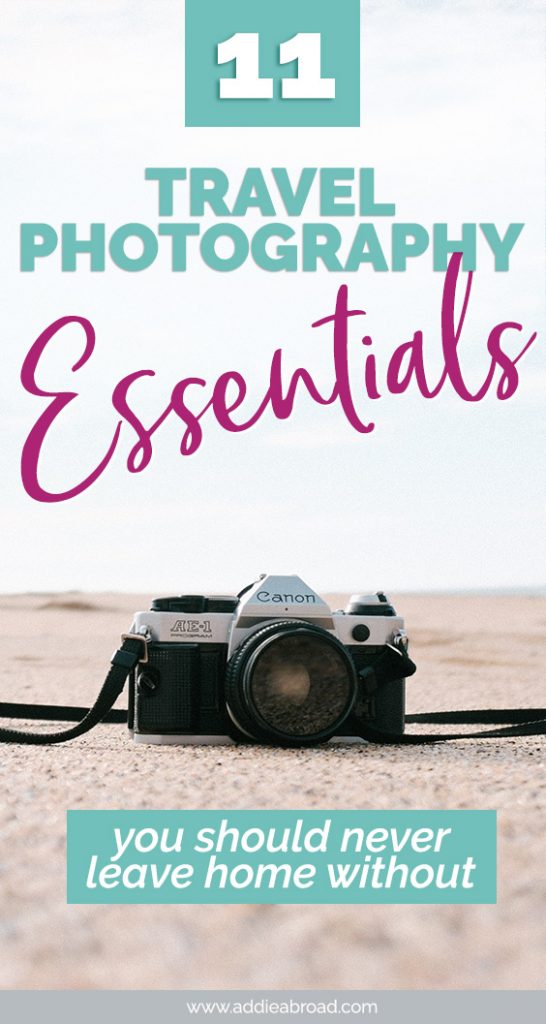Travel Photography Essentials: The Top 11 Lenses & Accessories You Should Never Leave Home Without

As an Amazon Associate, I earn from qualifying purchases. This website contains affiliate links, meaning that I may earn a commission if you make a purchase through those links. For more information about my affiliate partnerships, please visit my terms and conditions.
As awesome as it would be to be able to simply buy a camera and head out on your travels, you’ll soon find that the camera alone doesn’t cut it. In fact, there are a few travel photography essentials that you really can’t go without. All of these things make up your travel photography kit.
When it comes to putting together your travel photography kit, you definitely don’t want to go overboard. In fact, it’s best to just keep to a few photography essentials: 2-3 lenses, cleaning supplies, a filter or two, maybe a tripod, and a bag to carry it all in. Minimalism is definitely key!
But how do you know exactly what you need to bring and what’s just extra weight holding you down? In this post I’m going to go into my personal photography essentials: the things that are in my camera bag that I never leave home without, and talk about why you should be bringing these things along too in order to take great travel photographs!
↠ Don’t have a camera yet? Read my post about what to look for in a travel camera! ↞
Travel Photography Essentials: Lenses
Okay, I know what you’re thinking. Didn’t my camera come with a lens?
Technically, yes. But that lens your camera came with (typically referred to as a kit lens) is on the bottom of the spectrum in terms of quality. In order to keep camera prices low, manufacturers use cheap glass and other materials in their kit lenses. They also typically have a limited zoom range and functionality.
So while it is possible to take good photos with your kit lens, if you really want to take great travel photos, then a few good lenses should be your first investment (after the camera, obviously!). You don’t have to buy these all at once, obviously. On average I’ve added one lens every six months or so, and think that’s a pretty good rate. Really though, it’s all about what you can afford!
Zoom Lens

In my opinion, your first lens purchase should be a high quality, powerful zoom lens. The lens your camera comes with will likely not zoom beyond 70mm, and probably doesn’t zoom out very far as well.
The zoom lens that I literally always carry with me is an 18-105 mm lens, and I hardly ever take it off my camera. It truly is all-purpose, and it’s a fantastic addition to your photography essentials!
I’d suggest looking for a lens that has about this range, with an f-stop range of f/4-f/5.6.
Wide Angle Lens
Another great addition to your travel photography kit is a good, wide-angle lens. This will let you capture even more of the space around you, and especially helps in cramped spaces like interiors where you can’t back up to get more in the frame.
A wide angle lens should be less than 20mm and have an f-stop range of f/1.8-f/2.8.
Portrait Lens

If you love taking pictures of people, then a good quality portrait lens is an absolute must! Portrait lenses are generally 35mm, 50mm, or 80mm, and can stop down to f/1.8, allowing for those super creamy bokeh backgrounds.
I personally use a 35mm portrait lens and love it.
Accessories
So what else besides lenses is there to add to your camera kit? Well, a lot of stuff. Some things are definitely photography essentials, others are really only necessary on certain trips.
Extra Batteries

Very often you’re going to be out all day, without time to rush back to your hotel room and wait an hour or two while your battery recharges. And you definitely don’t want to be caught with a dead battery right when you arrive somewhere amazing (like when my camera died the second I walked into the Sagrada Familia in Barcelona).
So, what’s the best solution? Buy a pack of extra batteries (they usually come in twos)! That way, you’ll never be caught without a working camera on your travels.
Extra batteries are absolutely travel photography essentials.
Extra Memory Cards

In the same vein as the extra batteries, you don’t want to have to go back through your memory card and decide which photos to delete to make room for new ones when you’re just trying to enjoy your vacation. So instead, have an extra memory card or two on hand for when your first one fills up.
Tripod

You definitely don’t need a tripod for most trips, but they can be super useful if you want to photograph at night or photograph things like waterfalls or the northern lights. I also never travel solo without a tripod, so that I can always get the exact pictures of myself that I want.
When looking for a good travel tripod, look for one that is both lightweight and sturdy. You definitely don’t want to add more weight to your pack than you need to!
A carbon fiber travel tripod are the lightest weight you can get and have gotten a lot more affordable in recent years!
Remote Control

You probably only need a remote control if you’re going on a trip where you’ll also need a tripod. They’re super helpful for reducing camera shake when you are shooting with a slow shutter speed.
Additionally, a remote control with an intervalometer feature is very useful for taking photos of yourself!
Filters

There are a lot of different lens filters out there, and it can be tempting to bring them all along. But it’s really not necessary.
If you’re worried about lens scratches, then investing in some UV filters is a good idea. They don’t change anything, but are way cheaper to replace than a lens!
If you want to take pictures of water, then a polarizing filter is a good thing to buy. They reduce reflections.
Lastly, if you want to take a photo where the shutter is left open for a long time in bright conditions (for example a photo of a waterfall where the water is blurred), then you should bring along a neutral density filter, which lowers the exposure of your shots.
Cleaning Supplies

Finally, you definitely don’t want to be caught without a microfibre cloth to clean your lens and something to clean your sensor with if it gets dust on it!
You can usually get the dust off with a small sensor blower, but more stubborn dust might need a sensor cleaning kit like this.
Bags
Alright, now how the heck are you supposed to carry all this stuff around? A regular old backpack or purse is probably not a good idea because they do not provide nearly enough padding or organization. It’s definitely a good idea to buy a backpack or shoulder bag (or both) specifically made for cameras. They’ll not only protect your gear but will have thicker straps to save your shoulders.
Backpack


I personally love using a backpack for my photography gear whenever I can. Evening out the weight between both shoulders is a major plus, and backpacks can also just fit more stuff in them!
If you’re mostly exploring cities and want a camera backpack that doesn’t look like a camera backpack, I highly recommend the Jo Totes Bellbrook. It’s what I use for urban travel, and I’m completely obsessed with the stylish design and smart organization.
But if you’re heading out on hikes or doing more rugged travel, the Think Tank Backlight Sprint 15L is hands-down the best hiking camera backpack I’ve ever used. It’s lightweight but durable, fits my mirrorless camera, lenses, drone, GoPro, and even a compact tripod—with room to spare. Plus, it opens from the back panel for extra security on the trail.
There are also more budget-friendly options on Amazon. Look for one like this one that has a side pocket for quick and easy access to your camera!
Shoulder Bag

Shoulder bags are a great option for city trips or days when you’re only carrying a small amount of gear. They’re ideal if you’re just packing your camera with one or two lenses and want to keep things light and accessible.
The biggest advantage of a shoulder bag is easy, on-the-go access to your camera—perfect for street photography or moments when you don’t want to fumble with a backpack. Brands like Kindly Camera Bags offer stylish, high-quality options, while Amazon has more budget-friendly choices with padded inserts.
Just keep in mind that all the weight sits on one shoulder, so they’re best for shorter outings or lighter setups.
Pin it for later!








2 Comments